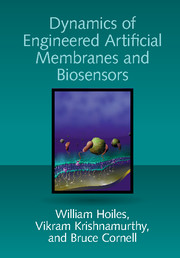Book contents
- Frontmatter
- Contents
- Preface
- List of Abbreviations
- Part I Introduction and Background
- Part II Building Engineered Membranes, Devices, and Experimental Results
- 4 Formation of Engineered Tethered Membranes
- 5 Ion-Channel Switch (ICS) Biosensor
- 6 Physiochemical Membrane Platforms
- 7 Experimental Measurement Methods for Engineered Membranes
- Part III Dynamic Models for Artificial Membranes: From Atoms to Device
- Appendices
- Bibliography
- Index
4 - Formation of Engineered Tethered Membranes
from Part II - Building Engineered Membranes, Devices, and Experimental Results
Published online by Cambridge University Press: 25 May 2018
- Frontmatter
- Contents
- Preface
- List of Abbreviations
- Part I Introduction and Background
- Part II Building Engineered Membranes, Devices, and Experimental Results
- 4 Formation of Engineered Tethered Membranes
- 5 Ion-Channel Switch (ICS) Biosensor
- 6 Physiochemical Membrane Platforms
- 7 Experimental Measurement Methods for Engineered Membranes
- Part III Dynamic Models for Artificial Membranes: From Atoms to Device
- Appendices
- Bibliography
- Index
Summary
Introduction
Engineered membranes are synthetic lipid bilayers that are used to mimic biological cell membranes in biophysical and physiological applications. Recall from Chapter 3 that engineered membranes are a fundamental component in building high-resolution sensing devices (such as the ion-channel switch [ICS] biosensor), building stable platforms for measuring the electrophysiological response of cells, and also for using diagnostic tools and implantable devices. From a more fundamental point of view, engineered membranes allow us to study the dynamics of lipids, proteins, peptides, and cells in a controlled environment.
Recalling the various types of artificial membranes summarized in Figure 3.2 on page 32, this book focuses exclusively on artificial tethered bilayer lipid membranes (tBLMs). The atomic structure of these engineered tethered membranes has been determined using several experimental techniques such as electrical measurements, X-ray reflectometry, and neutron reflectometry as will be discussed in Chapter 7. The unique feature of such membranes is that they are tethered to a conductive solid surface, namely, the bioelectronic interface. Tethering is used to improve the mechanical stability of the engineered membrane. The conductive gold surface to which the membrane is tethered also provides a convenient electrode to generate localized ion fluxes.
This chapter discusses two important synthesis aspects of engineered tethered membranes:
(i) How does one build a tethered membrane?
(ii) How does one insert specific lipids, proteins, and peptides into the membrane?
We stress that engineered tethered membranes have several advantages compared to other types of artificial membranes. One can precisely control the membrane stability via the tether density. Also a tethered membrane can withstand electrochemical excitations in the range of −900 to +900 mV and convection and advection flows, and it has a shelf life on the order of months. This remarkable stability, compared to traditional whole cell voltage clamping experiments, for example, is a result of the disulfide chemistry, the nanometer hydrophilic submembrane space between the bioelectronic gold interface and the membrane, and the flexibility of lipid composition. For example, it is standard to use 100 percent tether density to ensure the membrane is sufficiently stable to allow the cells to grow on the surface of the membrane.
- Type
- Chapter
- Information
- Publisher: Cambridge University PressPrint publication year: 2018
- 1
- Cited by



